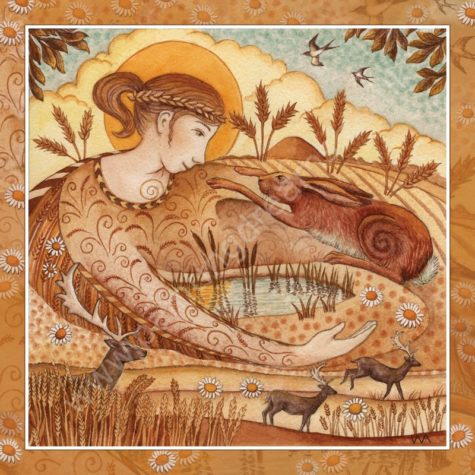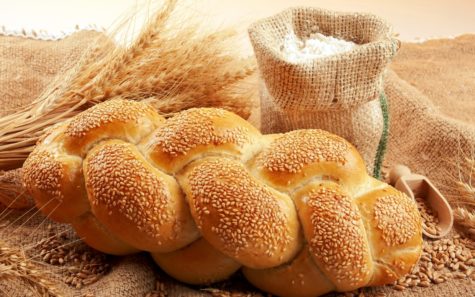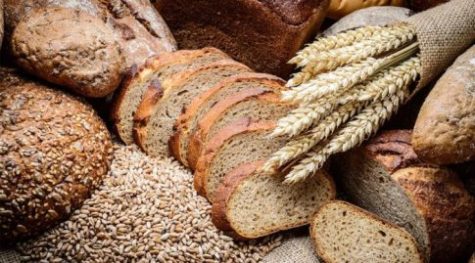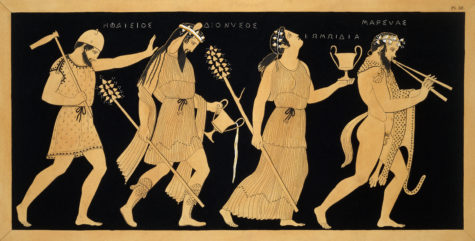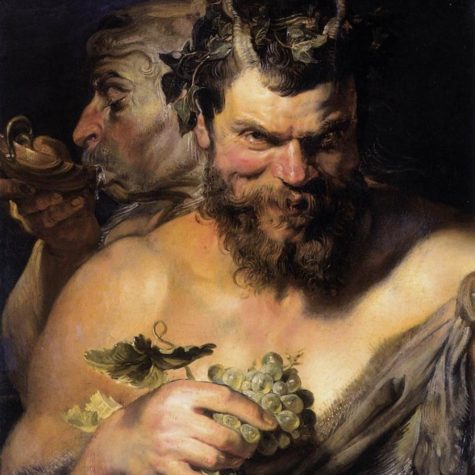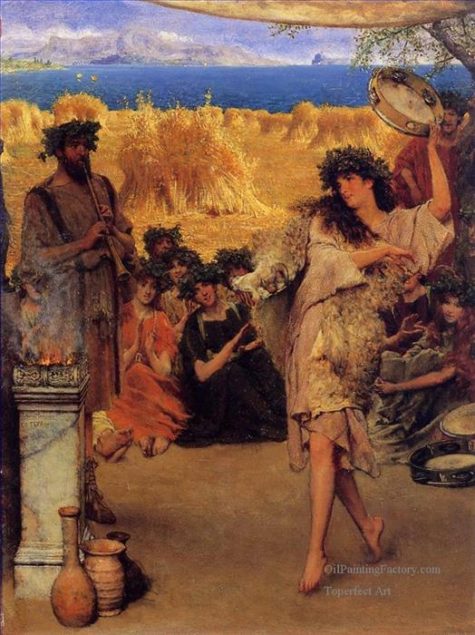Bread
Lammas is very old indeed. It derives from the ancient English festival the Gule of August, which marked the beginning of the harvest, traditionally August 1.
The early English church kept this pagan dedication of the first fruits but converted it to Christian usage. The word Lammas derives from the Old English phrase hlaf-maesse, which translates to loaf mass. In early Christian times, the first loaves of the season were blessed by the Church.
Through the centuries, “loaf-mass” became corrupted in spelling and pronunciation to Lammas. On Lammas Day, loaves of bread were baked from the first-ripened grain and brought to the churches to be consecrated.
To the Celts, this was Lughnasaid, the feast of the wedding of the Sun god and the Earth goddess, and also a harvest festival. In Ireland, baskets of blueberries are still offered to a sweetheart in commemoration of the original fertility festival. In Scotland, the Lammastide fairs became famous for trial marriages that could be ended without question after a year.
“After Lammas Day, corn ripens as much by night as by day.”
In early Ireland, it was a bad idea to harvest your grain any time before Lammas – it meant that the previous year’s harvest had run out early, and that was a serious failing in agricultural communities. However, on August 1, the first sheaves of grain were cut by the farmer, and by nightfall his wife had made the first loaves of bread of the season.
Bread is the ultimate symbol of the Lammas season. After all, once the grain is harvested, it is milled and baked into bread, which is then consumed. It is the cycle of the harvest come full circle. The spirit of the grain god lives on through us in the eating of the bread. In many traditions, a loaf of special bread is baked in the shape of a man, to symbolize the god of the harvest.
You can easily make a loaf of Lammas bread by using a pre-made loaf of bread dough, found in the frozen food section in your grocery store. Certainly, you can make your own dough, but if you’re not much of a baker, this is an easy alternative. Or, if you prefer to make your own, here’s a recipe: Lammas Bread
Sources: The Fairy Party Book and Almanac.com
Bread is the ultimate symbol of the Lammas season. After all, once the grain is harvested, it is milled and baked into bread, which is then consumed. It is the cycle of the harvest come full circle. The spirit of the grain god lives on through us in the eating of the bread. In many traditions, a loaf of special bread is baked in the shape of a man, to symbolize the god of the harvest.
You can easily make a loaf of Lammas bread by using a pre-made loaf of bread dough, found in the frozen food section in your grocery store. Certainly, you can make your own dough, but if you’re not much of a baker, this is an easy alternative. If you’d like to make your own, here’s a recipe:
Ingredients:
- 2 cups whole wheat flour
- 2 cups bread flour, plus more if needed
- 1/4 cup toasted sesame seeds
- 2 tablespoons active dry yeast
- 2 1/2 teaspoons salt
- 2 cups milk, scalded
- 3 tablespoons smooth peanut butter
- 3 tablespoons honey
How to make it:
Mix all the dry ingredients in a large bowl. Add the peanut butter and the honey to the hot milk and stir to combine. Cool milk mix until it reaches 115ºF. Stir milk mix into flour mix.
Knead for 15 minutes, adding more flour if necessary to make a smooth, elastic dough. Oil the dough’s surface, then cover with plastic or a damp towel.
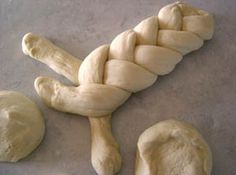 Let it rise in a warm spot until double. Punch down, then shape into 2 rectangle loaves, which could be subdivided into three equal sections and braided, or you could make one large braided wreath. Sometimes these loaves are shaped into “man” shapes, or if you’re really artistic, into a sheaf of wheat.
Let it rise in a warm spot until double. Punch down, then shape into 2 rectangle loaves, which could be subdivided into three equal sections and braided, or you could make one large braided wreath. Sometimes these loaves are shaped into “man” shapes, or if you’re really artistic, into a sheaf of wheat.
Let rise again until doubled. Bake at 375ºF until golden; it should make a hollow sound when tapped. Yield: 1 large or 2 regular-sized loaves
Source: The Fairy Party Book
Bread is a central feature in Lammas and Lughnasadh celebrations. Here’s a great recipe for whole grain bread:
In a large mixing bowl combine:
- 2 cups milk (warm to the touch)
- 2 packages of dry baking yeast
- 1 teaspoon salt
- 1/2 cup honey
- 1/4 cup dark brown sugar
Cover this mixture and set aside in a warm place until it has doubled (about half an hour). Add to this mixture:
- 3 tablespoons softened butter
- 2 eggs
- 1 cup of unbleached white flour
Stir until bubbly. Now mix in:
- 1/2 cup wheat germ
- 1/2 cup of rolled oats
- 2 cups stone ground wheat flour
- 2 tablespoons sesame seed
With floured hands, turn this dough out onto a floured board and gradually knead in more unbleached white flour until the dough is smooth and elastic and no longer sticks to your fingers.
Place this dough in a greased bowl, turning it so that the dough is greased. Then cover it with a clean cloth and keep it in a warm place to rise until it is doubled (about an hour).Then punch it down and divide it into two or more elongated loaves, roughly sculpted into mummiform shapes, and placed on greased cookie sheets.
Cover these and return them to a warm place until they double again. Bake the loaves in a pre-heated oven at 350 degrees for about an hour, or until they are done and sound hollow when tapped.
The Dionysia was originally a rural festival in Eleutherae, Attica, probably celebrating the cultivation of vines. It was probably a very ancient festival, perhaps not originally associated with Dionysus. This “rural Dionysia” was held during the winter, in the month of Poseideon (the month straddling the winter solstice, Dec – Jan).
The central event was the procession (pompe), in which a symbol of the phallos, sign of fertility, was carried through the dancing and singing procession. Young girls carried baskets, others carried long loaves of bread and other offerings, also carried in the procession were jars of water and wine. The pompe ended with a sacrifice consisting of baked bread or a gruel of cereal.
After the pompe procession was completed, there were contests of dancing and singing, and choruses (led by a choregos) would perform dithyrambs. Some festivals may have included dramatic performances, possibly of the tragedies and comedies that had been produced at the City Dionysia the previous year. This was more common in the larger towns, such as Piraeus and Eleusis. Generally, it was a joyful festival, shared by all, even the slaves.
Because the various towns in Attica held their festivals on different days, it was possible for spectators to visit more than one festival per season. It was also an opportunity for Athenian citizens to travel outside the city if they did not have the opportunity to do so during the rest of the year. This also allowed travelling companies of actors to perform in more than one town during the period of the festival.
The City Dionysia. also known as the Great Dionysia, was the urban part of the festival, possibly established in the 6th century BC. This festival was held probably from the 10th to the 16th of the month Elaphebolion (the lunar month straddling the vernal equinox, Mar – Apr in the solar calendar), three months after the rural Dionysia, probably to celebrate the end of winter and the harvesting of the year’s crops.
Ways to celebrate in modern times:
Sing, dance, play games, attend or participate in a parade or comedic theater of some sorts. Create phallic-shaped cakes for consumption and sacrifice. Read The Archanians by Aristophanies, which provides a glimpse of the festival. Display images and symbols of the God. Recite Orphic Hymns, Homeric Hymns, (all to Dionysos), or even hymns of your own creation.
I celebrate the Rural Dionysia following immediately the Heliogenna lasting through January 1. I pack baskets with gifts of nuts, wine, silly games and gifts, and DVD’s of comedies. Then I deliver those baskets, not more than one a day or evening, to friends and family. I spend the evening with the basket recipient and we eat the snacks, watch the DVDs, and drink the wine.
We also play the silly games and laugh. You don’t have to give the DVDs, you could just bring over a bottle of wine and a DVD from your collection or a netflix. That’s how I celebrate it since that is pretty close (in spirit) to what the Rural Dionysia was all about. – Cara Schulz
The Ancient Hymns
- The Fumigation from Storax.
Bacchus I call, loud-sounding and divine, fanatic God, a two-fold shape is thine: Thy various names and attributes I sing, O, first-born, thrice begotten, Bacchic king: Rural, ineffable, two-form’d, obscure, two-horn’d, with ivy crown’d, euion, pure. Bull-fac’d, and martial, bearer of the vine, endu’d with counsel prudent and divine: Triennial, whom the leaves of vines adorn, of Jove and Proserpine, occultly born. Immortal dæmon, hear my suppliant voice, give me in blameless plenty to rejoice; And listen gracious to my mystic pray’r, surrounded with thy choir of nurses fair.
- A Hymn
Come, blessed Dionysius, various nam’d, bull-fac’d, begot from Thunder, Bacchus fam’d. Bassarian God, of universal might, whom swords, and blood, and sacred rage delight: In heav’n rejoicing, mad, loud-sounding God, furious inspirer, bearer of the rod: By Gods rever’d, who dwell’st with human kind, propitious come, with much-rejoicing mind.
- The Fumigation from Manna.
Liknitan Bacchus, bearer of the vine, thee I invoke to bless these rites divine: Florid and gay, of nymphs the blossom bright, and of fair Venus, Goddess of delight, ‘Tis thine mad footsteps with mad nymphs to beat, dancing thro’ groves with lightly leaping feet: From Jove’s high counsels nurst by Proserpine, and born the dread of all the pow’rs divine: Come, blessed pow’r, regard thy suppliant’s voice, propitious come, and in these rites rejoice.
- The Fumigation from Aromatics.
Bacchus Pericionius, hear my pray’r, who mad’st the house of Cadmus once thy care, With matchless force, his pillars twining round, (when burning thunders shook the solid ground, In flaming, founding torrents borne along), propt by thy grasp indissolubly strong. Come mighty Bacchus to these rites inclin’d, and bless thy suppliants with rejoicing mind.
- To Dionysus
Of ivy-tressed uproarious Dionysus I begin to sing, the splendid son of Zeus and renowned Semele. Him did the fair-tressed nymphs foster, receiving him from the king and father in their bosoms, and needfully they nurtured him in the glens of Nysê. By his father’s will he waxed strong in the fragrant cavern, being numbered among the Immortals. Anon when the Goddesses had bred him up to be the god of many a hymn, then went he wandering in the woodland glades, draped with ivy and laurel, and the nymphs followed with him where he led, and loud rang the wild woodland. Hail to thee, then, Dionysus of the clustered vine, and grant to us to come gladly again to the season of vintaging, yea, and afterwards for many a year to come.
Sources: Wikipedia, Hellenionstemenos, and Project Gutenberg
August 25th is the Opconsivia, (or Opeconsiva or Opalia) the harvest festival of Ops, the Roman goddess of agricultural resources and wealth, also known as Opis. The festival marked the end of harvest, with a mirror festival on December 19 concerned with the storage of the grain.
- Themes: Opportunity; Wealth; Fertility; Growth
- Symbols: Bread; Seeds; Soil
About Ops: This Italian goddess of fertile earth provides us with numerous “op-portunities” to make every day more productive. In stories, Ops motivates fruit bearing, not just in plants but also in our spirits. She also controls the wealth of the gods, making her a goddess of opulence! Works of art depict Ops with a loaf of bread in one hand, and the other outstretched, offering aid.
To Do Today:
On this day, Ops was evoked by sitting on the earth itself, where she lives in body and spirit. So, weather permitting, take yourself on a picnic lunch today. Sit with Ops and enjoy any sesame or poppy breadstuff (bagel, roll, etc.) – both types of seeds are magically aligned with Ops’s money-bringing power. If possible, keep a few of the seeds from the bread in your pocket or shoe so that after lunch, Ops’s opportunities for financial improvements or personal growth can be with you no matter where you go. And don’t forget to leave a few crumbs for the birds so they can take your magical wishes to the four corners of creation.
If the weather doesn’t cooperate, invoke Ops by getting as close to the earth as you can (sit on your floor, go into the cellar). Alternatively, eat earthy foods like potatoes, root crops, or any fruit that comes from Ops’s abundant storehouse.
More About This Festival:
The Latin word consivia (or consiva) derives from conserere (“to sow”). Opis was deemed an underworld goddess who made the vegetation grow. Since her abode was inside the earth, Ops was invoked by her worshipers while sitting, with their hands touching the ground.
Although Ops is a consort of Saturn, she was also closely associated with Consus, the protector of grains and subterranean storage bins (silos). The festival of Consus, the Consualia, was celebrated twice a year, each time preceding that of Ops: once on August 21, after the harvest, and once on December 15, after the sowing of crops was finished.
The Opiconsivia festival was superintended by the Vestals and the Flamines of Quirinus, an early Sabine god said to be the deified Romulus. The main priestess at the regia wore a white veil, characteristic of the vestal virgins. A chariot race was performed in the Circus Maximus. Horses and mules, their heads crowned with chaplets made of flowers, also took part in the celebration.
Sources: Wikipedia and 365 Goddess
